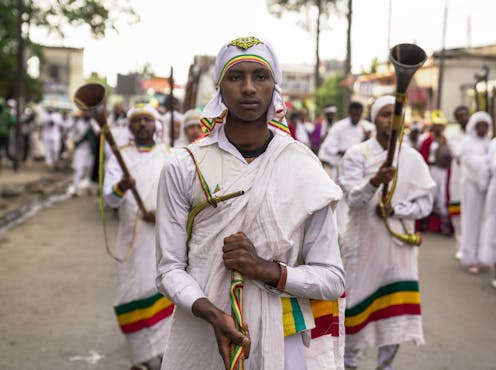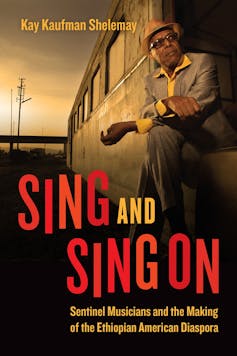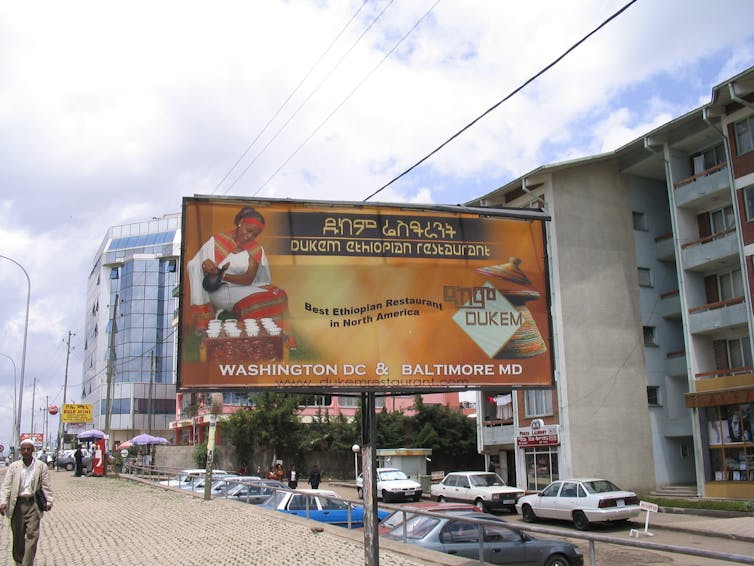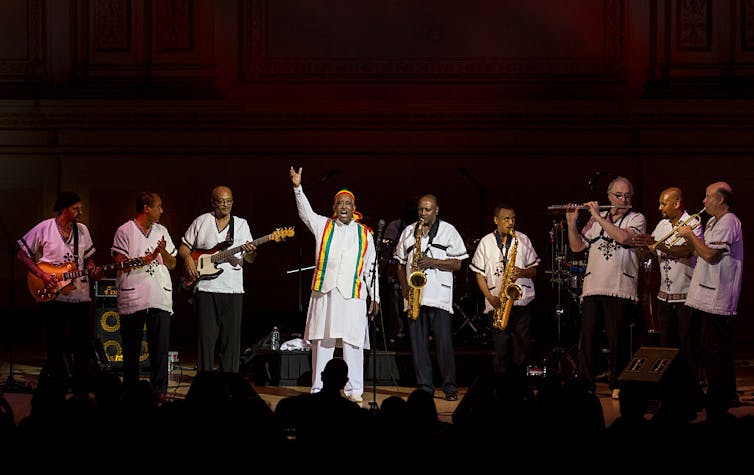
The overthrow of Ethiopian emperor Haile Selassie in 1974 led to violent conflict that had a particularly heavy impact on musicians. Sing and Sing On: Sentinel Musicians and the Making of the Ethiopian American Diaspora is the first study of the forced migration of musicians out of the Horn of Africa dating from the revolution. The book traces their struggles and what happened to their rich and diverse music traditions when they settled in the US. Ethnomusicologist Kay Kaufman Shelemay talks about her book.
What happened to cause musicians to leave Ethiopia?
Musicians were part of a mass outflow of people from the Horn of Africa that began as a direct outcome of the Ethiopian revolution. They fled due to the overthrow of the government, fear of the revolutionary Marxist military regime, and extreme violence across the country – as well as a civil war with Eritrea. Many refugees were Ethiopian Orthodox Christians from the Amhara ethnic group that had historically been close to circles of power.

The conflict caused bloodshed across a region already destabilised by drought and famine. Waves of refugees crossed into Sudan and Kenya, from where many eventually made their way to destinations around the world.
The revolution had a particularly strong impact on musicians in all genres. They feared imprisonment and forced musical activity by the revolutionary regime. The military junta nationalised urban and rural land, property and businesses. It disbanded most established musical ensembles and imposed strong censorship. This was due, in part, to concern about the power of music to encourage resistance. New, explicitly revolutionary musical groups and organisations were established to support their new programmes.
Read more: The astonishing life and music of Emahoy Tsegué-Maryam Guèbrou, the Ethiopian nun who's died at 99
Most musical performances were halted by curfews. Prohibitions against public gatherings rendered musicians unable to earn a living. The highly trained musicians of the Ethiopian Orthodox Church experienced a great loss of prestige along with severe economic pressures. These stemmed from the nationalisation of church resources.
How did you go about researching their stories?
I arrived in Ethiopia to carry out research for my doctoral dissertation in ethnomusicology in 1973. As outlined in my memoir, I was able to remain in Addis Ababa during the first two years of the revolution. There I witnessed the violence and the cessation of public musical life. I noticed a growing number of surreptitious departures.
When I returned to the US in early 1976, I encountered the first wave of those refugees. While I had gone to Ethiopia to study its musical life, by 1977, these musicians were now settling in all around me. I began to visit newly founded Ethiopian and Eritrean Orthodox churches as well as new Ethiopian restaurants and shops.

Over decades, I visited many Ethiopian communities across the US, I attended diaspora concerts and collected Ethiopian CDs released in North America, I interviewed musicians about their lives and immigrant experiences. I wanted to document the role of music in new Ethiopian communities in the US.
What role did musicians play in Ethiopia?
The powerful role of Ethiopian musicians both at home and abroad has led me to term these individuals “sentinel musicians”. I coined this phrase after repeatedly witnessing the way in which these musicians, past and present, both guarded and guided the communities they were a part of.
The word “sentinel” was also inspired by the bravery of musicians who historically accompanied Ethiopian troops into battle. Emperor Selassie had established the Imperial Bodyguard Orchestra and a jazz band as part of his elite personal militia.
Singers and instrumentalists have long been acknowledged as pivotal figures in Ethiopia. They guided the transmission and performance of cultural traditions in domains from worship to entertainment while offering inspiration and comfort during times of hardship.
How was this role continued in the diaspora?
The role of the musician in society is heightened in times of conflict and forced migration, when music and its performance could convey controversial meanings. In Ethiopian languages, there is the practice of employing double meanings in songs, masking the true intent of a text. This practice, termed “wax and gold”, is found in Ethiopian religious and secular poetry, in everyday speech, and in many song lyrics.
The wax is the obvious outer meaning of the words while the gold is the meaning hidden within. The term is borrowed from the “lost wax process” of casting smelted gold in wax moulds. Composers and traditional improvisational singers disguise the meaning of their songs, masking critical or controversial information.
In the diaspora, some sentinel musicians have continued to employ wax and gold, but musicians’ roles have also expanded to incorporate new and different significances.

Some have quite literally served as “sentinel stars”. They led the way to new locales, established transnational networks and founded new institutions – cultural organisations, churches, restaurants and clubs – undertaking initiatives in community building. Moreover, musicians have offered emotional support and healing to their displaced communities through their music.
All genres of Ethiopian music, from sacred to secular, have had to adapt creatively to their new homes abroad. Some diaspora musicians, like Ethiopian-Canadian singer Abel Tesfaye (formerly The Weeknd), have innovated personal styles that have risen to the top of global charts. Throughout the global diaspora, Ethiopian traditional music associated with different ethnic communities actively survives and is performed at events such as weddings and holiday parties.
At the same time, Ethiopian musicians of many different backgrounds both at home and in the diaspora perform international musical styles, ranging from jazz to reggae to rap. These are often inflected by distinctive Ethiopian melodies and rhythms. Some new musical repertories have emerged that are shared by Ethiopians at home and abroad, notably the performance of vernacular hymns that became popular during the revolution. They are sung internationally in Ethiopian churches by choirs of women and girls.
Why do their stories matter?
Musicians’ stories shed new light on the plight of refugees and the process of forced migration, providing a fuller understanding of the powerful role of music and musicians within rapidly changing societies.
Read more: Hachalu Hundessa: charismatic musician who wasn't afraid to champion Ethiopia's Oromo
Musicians use music and its performance to bring people together and to establish and sustain community values and moral standards. Through their stories and lived experiences, we can appreciate the impact of musical creativity, and the ways it is often deployed against formidable odds.
Kay Kaufman Shelemay received fellowships and grants for the research and publication process for this book from the National Endowment for the Humanities; the John Simon Guggenheim Memorial Foundation Fellowship; and Harvard University. I held residential fellowships at the Stanford University Humanities Center; the Rockefeller Foundation Bellagio Study and Conference Center; The Radcliffe Institute for Advanced Study of Harvard University; and the Chair in Modern Culture at the John W. Kluge Center, The Library of Congress.
This article was originally published on The Conversation. Read the original article.







